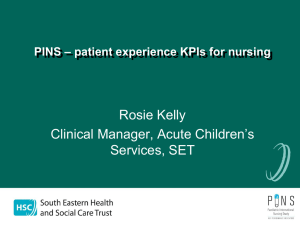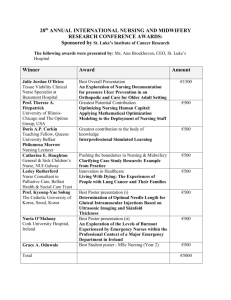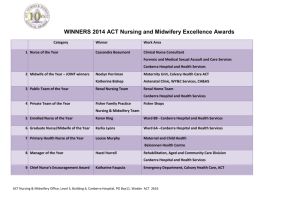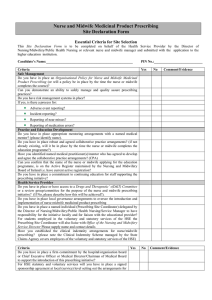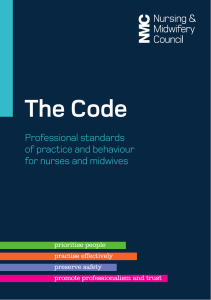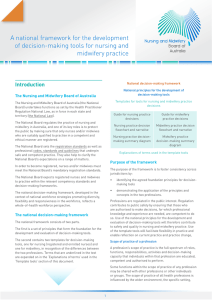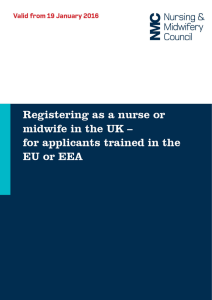Improving the Patient Experience through Nursing & Midwifery KPIs
advertisement
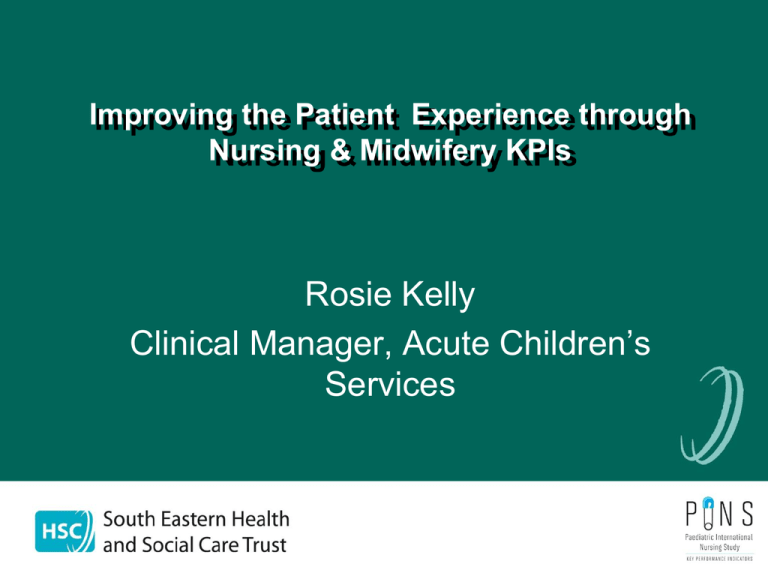
Improving the Patient Experience through Nursing & Midwifery KPIs Rosie Kelly Clinical Manager, Acute Children’s Services Most frequently cited indicators..... • Pressure ulcer incidence • Failure to rescue • Rates of health care associated infections (of varying types) • Incidence of falls • Medication errors • Hand hygiene • Nutritional status • Incidence of complaints (National Research Unit 2008) The gap? A lack of focus on indicators that measure the broader impact of nursing and midwifery care and which contribute to the quality of the patient experience “Patient experience of compassionate care is an important outcome in its own right and may provide the best measure of the nursing contributions to shared outcomes and evaluation of processes that are otherwise elusive” (p.24), (National Research Unit 2008) Final 8 top ranked KPIs Key Performance Indicator 1. Consistent delivery of nursing/midwifery care against identified need 2. Patient’s confidence in the knowledge and skills of the nurse/midwife 3. Patient’s sense of safety whilst under the care of the nurse/midwife 4. Patient involvement in decisions made about his/her nursing/midwifery care 5. Time spent by nurses/midwives with the patient 6. Respect from the nurse/midwife for patient’s preference and choice 7 Nurse/midwife’s support for patients to care for themselves, where appropriate 8 Nurse/midwife’s understanding of what is important to the patient Measurement framework Strongest Source of Evidence Data Collection Methods Asking patient • Survey • Patient Stories Observing practice • Observations of practice Asking nurses/midwives • Interview Reviewing documentation/data • Reviewing the patient record Implemented through 2 cycles of data collection comprising .... • 3 patient stories per cycle • 3 Observation of Practice per cycle • 10 Patient Records / Staff Interviews per cycle • Patient Satisfaction Survey – administered on discharge and continuous throughout project • Retrospective review of compliments and complaints Our Experience • • • • • • Very positive Staff engagement from beginning was key Support from Project Team Triangulation added weight to findings Claims, concerns, issues kept everyone engaged Observations of Practice – timings & activity Organisational Context Organisational Indicators EXAMPLES •Reported number of falls •Pressure ulcer incidence •Nurse facilitated discharge rates •Compliance with hand hygiene Patient/ Client EXAMPLES •Patient’s confidence in the knowledge & skills of the nurse •Nurse’s understanding of what is important to the patient •Time spent by nurses with the patient •Involvement of patients in decisions about their nursing care EXAMPLES •Performance against supervision standard •Attendance – management rates •Management of salaries & wages budget incl Bank, Agency & overtime Paediatric International Nursing Study (PINS) European sites Craig Ward, Ulster Hospital Royal Belfast Hospital for Sick Children Temple Street Children’s University Hospital, Dublin Worthing Hospital, East Sussex Great Ormond Street Hospital East Kent NHS Trust Hans Christian Anderson Hospital, Denmark Australian sites • • • • • Princess Margaret Hospital for Children, Perth Northern Sydney Local Health District Nepean Blue Mountains Local Health District The Women's and Children's Hospital, Adelaide The Sydney Children’s Hospital’s Network (Orthopaedic, Middleton & Edgar Stephens) Stages The project will be delivered through six stages. • Stage 1: Develop the framework for measurement • Stage 2: Implementation of the KPIs and measurement framework • Stage 3: Supporting practice change and innovation • Stage 4: Implementation of the measurement framework (repeat stage 2 & 3) • Stage 5: Evaluation of the implementation process • Stage 6: Hypothesis generation and preparation of final research report Data Collection & Analysis Timeframe 1 2 3 4 5 6 7 8 9 10 Survey Survey Survey Survey Survey Survey Survey Observation Analysis Feedback Stories Stories Transcribe Analysis Document • • • • Survey – distributed to all patients on discharge (over 7 weeks) Stories – 3 family stories over 1 week and 3 patient stories over 1 week Document – review patient record in conjunction with asking staff about patient goals (10 reviews over 1 week) Observation – of nursing presence in a specified bay over a 30 minute time period (3 over 1 week) Challenges • Time out for staff • Using new data collection tools • Recognising action plans as positive tools Using the KPIs to change and improve practice Diagnostics (& evaluation) Changing practice Interventions underpinned by participatory collaborative approaches In conclusion ....
